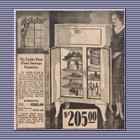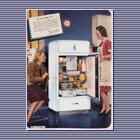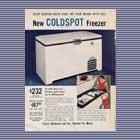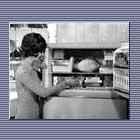|
When the Coldspot electric refrigerator debuted in 1928, it
was somewhat of a novelty. Most early refrigerators were
expensive and suffered from design and maintenance problems. The
Coldspot, however, met with immediate public acceptance, and the
1929 model was a main point of interest for visitors to the
Paris International Exposition that year.
Sears knew that there was a large market for electric
refrigerators, but that costs prevented most people from buying
them. So, Sears decided to design its own refrigerator. At the
time, most refrigerator manufacturers were building 4-cubic-foot
models. Sears wanted to build a 6-cubic-foot model and sell it
at the price of a 4-cubic-foot model.
Sears hired Herman Price, a well-known refrigerator engineer,
to help with the project. Then, in 1934, Sears hired industrial
designer Raymond Loewy to completely redesign the Coldspot
refrigerator. Price and Loewy incorporated a contemporary
streamlined design, plus new ideas that improved both the
reliability and serviceability of the refrigerator. These men
also pioneered the use of aluminum for refrigerator shelving. In
one year, sales of the Coldspot soared more than 300 percent.
Over the years, Sears' Coldspot line of refrigerators,
freezers and air conditioners featured several other product
innovations. In 1953, Coldspot upright freezers included dense
fiberglass insulation that saved on electricity, plus a cabinet
guaranteed not to "sweat." The Coldspot "Cold
Guard" debuted in 1960 as the first frostless refrigerator,
and 1971's model included a built-in cold-water dispenser and an
improved "humidrawer" food crisper.
By 1977, however, the brand recognition of Kenmore was so
great that most people surveyed by Sears believed that Kenmore
already had a line of refrigerators, even though it did not.
Sears then decided to replace Coldspot with Kenmore on all Sears
refrigerators, freezers, and air-conditioning units.
|






